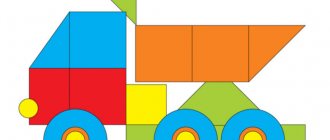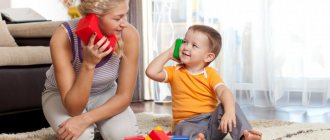Why preparation is needed
This preparation involves not only the acquisition by children of certain knowledge, but also its formation. In such classes, children develop various ideas about the world around them, such as spatial, quantitative, temporal and many others. It is important to develop thinking precisely in preschool age, so that the child learns to solve various kinds of tasks and is ready for the gradual complication of the program. Depending on the age group, children undergo different educational programs in kindergarten. In our group, children, in particular my child, get acquainted with geometric shapes and their colors, which helps develop imagination and imaginative thinking.
In groups where older children are already working with numbers and solving simple problems.
Such preparation is necessary in preschool age, because it is during this period that the child’s perception of the outside world is formed, and thinking begins to develop from the age of 2. My son finds such activities interesting and fun. Sometimes at home we cut out the same shapes from paper, draw on them, and build pyramids from three-dimensional shapes.
Mathematics lesson in 1st junior group. Circle and square
Summary of a lesson on the formation of elementary mathematical concepts in the 1st junior group.
Topic: Geometric figures: circle and square Purpose: to consolidate ideas about geometric figures - circle and square. Objectives: Educational:
- teach to recognize, distinguish and find geometric shapes: circle and square;
- learn to correlate a geometric figure with its model; - teach children to navigate in space, use prepositions -under, -for, -7na Developmental:
- develop attention;
- develop the ability to analyze and work with didactic material Educational:
- cultivate interest in joint activities with peers;
- develop a sense of community; - cultivate a sense of empathy for the characters Speech:
- development of coherent speech - teach children to answer the question “how much?”
the word "a lot"; - use of words in speech: circle, square, round shape, square shape. Preliminary work: • Reading fiction “Zayushkina’s Hut” • D/i “Geometric Figures” • Games “Fox and Hares” • Finger gymnastics “House” Developing subject-spatial environment: Dienesh blocks (circles and squares of different sizes and colors), 2 houses, pictures with square and round objects, toys: a fox and a hare, a circle and a square made of cardboard.
Progress:
Chairs on the carpet in a semicircle.
Educator: Children, sit down on the chairs. The back was straightened, the arms were placed on the knees. There's a knock on the door. Educator: Guys, who is that knocking? I'll go open the door. (I take the hare and fox toys) That's who knocked on our door! Did you find out? Children: Yes, it's the fox and the hare. Educator: Where do you think they came to us from? Children: from the forest. Educator: Do you remember the fairy tale about the fox and the hare? Children: Yes, Zayushka’s hut. The fox kicked the bunny out of the house because her hut had melted. Educator: Correct. But now the fox and the hare have become friends, the fox promised not to offend the bunny anymore. Today they came to visit us so that the children could help them build houses. Let's help the animals? Children: Yes! Educator: Let's get down to work together and build new houses for the fox and the hare. And let them “walk” around our group. Finger gymnastics All day long knock and knock - a ringing sound is heard (hands clenched into fists, thumb raised up, tapping on the index finger) Hammers knock (knock fist on fist) We build a house for the animals. This is such a good house. How wonderful we will live! (show “roof”) Educator: These are the kind of houses we got! Where are our little animals? Let's go look for them. Are they near the closet? Children: No Teacher: Is there something under the table? Children: No! Jr. At this time, the teacher scatters Dienesh blocks in the form of a path on the floor. Educator: That's where they are! They hid behind the sofa! Dana, where are the little animals hiding? Children: Behind the sofa. (I ask 3-4 children) Educator: Fox, bunny, we built houses for you, let’s go have a look. Oh, there's a blockage on our way. How will we get to the house?! To go further, we need to clear the road. Guys, these are not ordinary stones. Look what shape they are? What geometric shapes do they resemble? Children: circle and square. Educator: Well done! Let's clear the path of stones. We will put all the round pebbles on the round “stump”, and square-shaped pebbles on the square “stump”. What shape of pebble did you take? Why did you put it here? (2-3 children) Good guys, everyone did it! Because we worked together, because together it turns out faster and better: everyone managed to arrange the pebbles into shape. Look! These are houses. But they are different. What is painted on this house? Children: circle Teacher: And in the other house? Children: square Educator: How can we now understand who gets which house? Look, the animals have badges. What shape is the fox's badge? Children: square Teacher: What about the bunny? Children: round Teacher: Well done! Now we know where whose house is. Let's plant them next to our houses. Bunny, your house is round. What should we say to the fox? “Fox, your house is square.” Let's visit each other together. And you, kids, sit down on the chairs. Guys, there is nothing in the houses of the fox and the hare. How to be? We need to help them arrange their huts. Are you ready to help? Children: Yes Educator: I have pictures, but they are not simple. Some objects on them are round, and some are square. What do you think we should put in the fox’s house? What shape? Children: square Teacher: What shape of objects should we put in the house for the bunny? Children: Round. Educator: Why? Children: Because the bunny has a round icon. I suggest going to the table and taking 1 picture. Ask the children: “What is shown in the picture? What shape? Who needs to be put in the house?” Educator: Well done. You were able to determine the shape of objects in the pictures. The animals became cheerful and happy! Because their house is no longer empty, it has many items that they need every day. They thank you for their new homes, for being able to furnish them, and invite you to play with them and celebrate their housewarming. Outdoor game “Fox and Hares”
We leave the animals in the houses, say goodbye to them
Teacher, Children: Goodbye, fox and bunny! All the best to you!
We recommend watching:
Summary of GCD in the 1st junior group on FEMP “Let's treat the Bunny with a carrot” Summary of GCD in the 1st junior group on the formation of a holistic picture of the world Summary of a design lesson in the 1st junior group Summary of a lesson with children of the first junior group
Similar articles:
Summary of GCD in the 1st junior group by February 23
Lesson notes for the early childhood group in kindergarten
Lesson summary for an early age group. Cockerel
Lesson summary for an early age group. Dandelion
Summary of a game development lesson in kindergarten in the second group of early age on the topic: Toys


